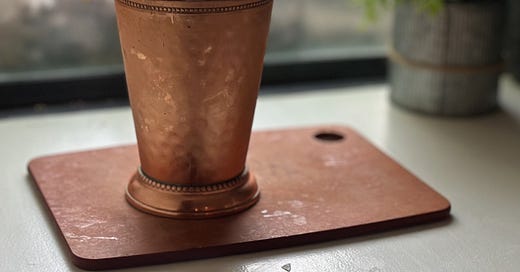Mod Your Mint Julep
Honey, mezcal, and brandy in a not-quite Julep. Also, a lot of discussion of ice.
Links About Drinks
The Athletic ranks sports-related signature drinks. Not surprisingly, the Mint Julep comes in at number one.
Also in cocktail rankings: This year’s list of North America’s 50 Best Bars dropped this week. For the second year in a row, Mexico’s Handshake Speakeasy topped the list, and New York’s Superbueno came in second. Two of the most notable new entries are Washington, D.C.’s Silver Lyan, which appeared on the list for the first time at number 48, and Sip & Guzzle, a fairly recent New York cocktail joint that leapt onto the list at number 5. Meanwhile, D.C.’s highest ranked bar is the casual, fun, and low-key excellent Service Bar, at no. 23. Since it came up in the comments recently: I can’t vouch for every bar or ranking choice, but I do think the list is a reliable guide to ambitious (and yes, often somewhat spendy) cocktail bars. These aren’t the only good bars on the continent, but I’ve never been to a ranked bar that didn’t impress me. The 50 Best guide is also a good barometer of where the cocktail scene is going. This year’s list suggests a shift away from the dark-and-moody vibes of the early cocktail renaissance, and towards bars that are either more elegant and sophisticated (Martiny’s, Overstory, Silver Lyan) or raucous, party-friendly, and even deceptively casual (Superbueno, Service Bar).
Speaking of Mint Juleps
Each year when the Kentucky Derby approaches, I think of the opening lines to Richard Barksdale Harwell’s delightful 1975 book on the Mint Julep: “Wherever there is a Mint Julep, there is a bit of the Old South. For the julep is part ceremony, tradition, and regional nostalgia; part flavor, taste, and aroma; and only by definition liquor, simple syrup, mint, and ice. It is all delight. It is nectar to the Virginian, mother's milk to the Kentuckian, and ambrosia to Southerners anywhere.”
I am not a Southerner. Not by birth, anyway. I was born in Ohio, to parents who hailed from Pennsylvania and Minnesota. The word “y’all” was not part of our household lexicon. We didn’t yet drink sweet tea.
But I spent most of my youth in Southern environs. Around the time I started grade school, my family moved to North Carolina, and then a few years later to the Florida Panhandle, which culturally might as well be Southern Alabama. Later, I spent several of my college years in Kentucky, a place I remain quite fond of.
Sweet tea and y’all became part of my life. And so, eventually, did Mint Juleps. But it took quite a while.
That’s because too many Mint Juleps are made carelessly—without thought to the balance of flavors and ingredients, which can be tricky to master, even for the best bars and bartenders. Indeed, most Mint Juleps are not made with care by the best bartenders, but produced quickly, almost assembly-line style, for the race day masses.
Indeed, the proper preparation of a Julep has long been the subject of debate and strong opinion. Harwell’s book goes on to quote one General Simon Bolivar Buckner1 on the process by which one makes a Julep: “A Mint Julep is not the product of a formula—it is a ceremony and must be performed by a gentleman possessing a true sense of the artistic, a deep reverence for the ingredients and a proper appreciation of the occasion. It is a rite that must not be entrusted to a novice, a statistician, nor a Yankee.”
I am sympathetic to this notion, to the insistence on the art and romance of the Julep. But—and not to sound too much like a statistician—I think it is, in fact, a formula. There’s a way to make a Mint Julep that works. And there are a lot of ways that don’t.
And because it’s a formula, it can be modified, through swaps, substitutions, and adjustments that make for a radically different cocktail that is nonetheless built on the same underlying principles.
So this week, we’re going to return to the Mint Julep. We’ll look at my own favorite recipe, and break down what makes it work—so folks who want to make a classic Mint Julep for Derby Day can do so. We’ll talk a lot about ice.
And then we’ll make a totally different drink that employs honey, mezcal, and apple brandy in a Julep-like format.
As I often say: Where there’s one good drink, there are more good drinks. It’s true of the Julep too.
Mint Condition
Fundamentally, the Mint Julep is just a minty variation on the Old Fashioned.
Where the Old Fashioned combines bitters, sugar, and whiskey, the Mint Julep combines mint, sugar, and whiskey, with the mint playing a version of the role that bitters play in an Old Fashioned.
Or at least, that’s the traditional way to make a Mint Julep. One of my strongest outside-the-mainstream cocktail-related beliefs is that a Mint Julep should have a dash of Angostura Aromatic bitters. Without the bitters, you end up with what amounts to bourbon + made-in-glass mint syrup, which invariably ends up somewhat cloying, or at the very least, lacking in the grounded complexity that bitters provide.
The other signature element of the Mint Julep is the ice.



